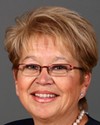Thank you very much.
My opening statement will be taking the better part of my ten minutes, but if the committee would permit, I would like to introduce the members with me today.
I have Linda Savoie, who's the director general of the women's program; Sébastien Goupil, whom I believe some of you have met at an earlier appearance on the census; and Johanne Tremblay, who is the CFO for the organization.
Thank you, Madam Chair. I am pleased to be here with you today to talk about the supplementary estimates of Status of Women Canada. As the first anniversary of my appointment as coordinator approaches, I find myself amazed at how quickly the year has gone by—and how much we have achieved!
Let me begin by noting that we are in the midst of the worldwide 16 Days of Activism against Gender Violence, which began on November 25 with the International Day for the Elimination of Violence against Women. This period provides an opportunity to raise awareness of this enduring problem and to encourage Canadians to take concrete actions to eliminate all forms of violence against women and girls.
Status of Women Canada works to promote equality for women in Canada. To achieve concrete and tangible results on this front is a shared responsibility. This requires strategic interventions on our part, as well as on the part of other federal organizations such as DFAIT, which you heard from today, and stakeholders at all levels, both within and outside of government.
The issues affecting women cannot be addressed by one organization alone. Over the past year, we have invested significant effort in developing partnerships. Status of Women Canada acts as an enabler, a facilitator, and a knowledge broker, starting with the federal family and federal organizations, and extending well beyond, to provincial and territorial governments, NGOs, academics, and others.
Status of Women Canada, and the women's program in particular, operates in three broad areas to advance equality for women and remove barriers to their participation in society. Those areas are: leadership; economic security and prosperity; and, very importantly, ending violence against women, with emphasis on remote, aboriginal, and immigrant communities.
Through our policy work, we seek to influence and support the efforts of our partners. We endeavour to help others understand their roles in promoting equality for women and seize the opportunities that this presents, regardless of whether their mandate deals with economic development, law enforcement, social housing, or prevention of violence.
When I last appeared in front of this committee, I indicated that I had begun discussions with Statistics Canada on the publication of the sixth edition of “Women in Canada”. In fact, Status of Women Canada will receive a transfer of $129,000 in its operating budget in the 2010-11 supplementary estimates (B) exercise for this purpose.
I'm proud to announce today that the first chapter on paid work will be released this December, with the remaining chapters published over the course of the next year. This is a fine example of the central role Status of Women Canada plays in ensuring that sex-disaggregated data is available to inform policy and program-making.
More than a dozen federal organizations have contributed to this initiative, both financially and in terms of advice and consultations. I would like to take this opportunity to thank them.
Another key lever to advance equality for women is gender-based analysis, which, as you know, has received well-deserved attention over the past year. Implementation of the GBA Action Plan is providing federal organizations with an opportunity to reflect on how to entrench the sustainable practices required to inform decision-making.
Status of Women Canada will continue to focus on making the framework and tools relevant, in particular for areas where legislation, policy and programs are often assumed to be gender-neutral. It is also important to note the growing interest of other House committees in gender-based analysis and related issues.
This year, we made changes to the Women's Community Fund. These changes will allow organizations to work more collaboratively with Status of Women Canada to create the best possible environment for advancing equality for women in our country.
As well, other federal departments are now involved in reviewing applications, which provides a broader representation of expertise and potential funding partners. As I mentioned earlier, Status of Women Canada focuses a good deal of its energies and its resources on the issue of violence against women. Why? Because today, one in two women will experience violence in her lifetime. And because, in 2008, there were 146 female victims of homicide in Canada, 45 of whom were victims of spousal homicide.
Young women experience the highest rates of violence. Girls under the age of 18 experience sexual assault by family members at a rate four times higher than for boys. And as we know, Aboriginal women continue to experience high rates of violence and homicide, a situation that remains unacceptable.
The impacts of this violence are far-reaching—not only are they devastating to the victim, but also to her family, to our society, to our economy and to our health care system. Status of Women Canada works in partnership with organizations across the federal government. For example, we are working with the RCMP to train officers to better identify and help victims of human trafficking.
We are a partner in the cross-governmental Family Violence Initiative chaired by the Public Health Agency of Canada and through which we have recently begun mapping government interventions in this area.
We also recognize that collaboration with our provincial, territorial and community-based partners is essential to success in addressing violence at every level.
Among our current collaborative efforts, Status of Women Canada is providing funding to the Newfoundland Aboriginal Women's Network to implement a community crime prevention and awareness initiative that targets violence against women. This project's key strength is its recognition that lasting change requires the involvement of a full range of stakeholders in the community.
Economic security and prosperity is another area of priority. Indeed, a healthy economy for all Canadians is the government's top priority. Women play a critical part in securing Canada's economic prosperity.
Many advances have been made with respect to women's participation in the workforce. Still, there is work to be done—for example, while we are seeing more women in fields such as human resources and business, they continue to be underrepresented in science, engineering, and trades.
Non-traditional occupations present a tremendous opportunity for women. This committee has done some important work on this issue and on how to encourage women to pursue careers in fields where labour shortages are anticipated and the remuneration is attractive.
In recent weeks, Minister Ambrose has announced some promising and innovative projects that have received funding, such as the Centre for Women in Science, Engineering, Trades and Technology, WinSETT, leadership program, which will promote women's active participation in non-traditional work and leadership and will include a particular focus on aboriginal and immigrant women.
We've made important strides in women's participation in leadership. This year's World Economic Forum gender gap report ranks Canada 20th out of 134 countries, compared to 25th in 2009. As of 2010, women hold 22% of the seats in the House of Commons, 34% of those in the Senate, and 27% in federal cabinet posts.
However, we still have a way to go, particularly in some areas—for example, while women now make up 47% of the labour force, over 40% of private companies have no women on their boards of directors. To address this issue, Status of Women Canada recently provided funding to The Jeffery Group for a project called “The Bottom Line: Gender Diversity at the Board Level”. This promising initiative aims to increase the number of women on Financial Post 500 boards of directors.
In closing, I want to stress the excellent working relationships that Status of Women has with other federal departments and agencies, other levels of government and civil society. Our work is necessarily collaborative and could not be achieved without the invaluable support of our partners.
Thank you for permitting me to make this presentation. I welcome the committee's questions.








